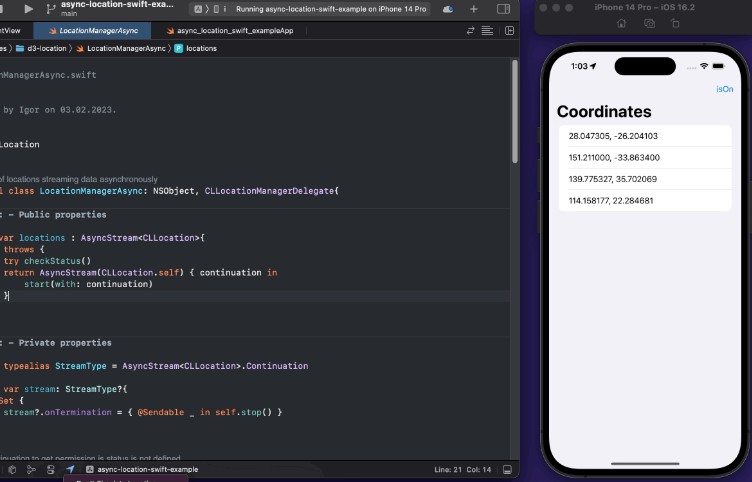LocationSpoofer
Description
This package provides a simple wrapper around libimobiledevice and some internal Apple APIs in CoreSimulator to allow spoofing the location of iOS devices or iPhoneSimulator devices.
Structure
There are two main classes: IOSDevice and SimualtorDevice. Use the IOSDevice class if you want to interact with real devices. Use SimualtorDevice when interacting with the iPhoneSimulator. Both classes conform to the Device interface. For simple location spoofing cases you can use these classes directly. The Device interface defines all necessary functions to set and reset the current location.
For more complex location manipulation this packages includes the LocationSpoofer class. This class is initialized with a device instance and allows you to automatically update the location based on specific criteria.
List devices
You can either list all available devices using:
let iosDevices: [Device] = IOSDevice.availableDevices
let simDevices: [Device] = SimulatorDevice.availableDevices
or you can listen for new devices. To start/stop the listening process use:
IOSDevice.startGeneratingDeviceNotifications()
SimulatorDevice.startGeneratingDeviceNotifications()
...
// If you don't need updates anymore
IOSDevice.stopGeneratingDeviceNotifications()
SimulatorDevice.stopGeneratingDeviceNotifications()
To respond to the notifications, register a notification observer and bind it to a function:
// You can also use: .DeviceChanged, .DevicePaired or .DeviceDisconnected
NotificationCenter.default.addObserver(self, selector: #selector(deviceConnected), name: .DeviceConnected, object: nil)
@objc func deviceConnected(_ notification: Notification) {
let device = notification.userInfo?["device"] as? Device
...
}
Location change
You can then directly interact with the device. You can change the current location by using:
// Change the location
let destination = CLLocationCoordinate2D(latitude: 1000, longitude: 1000)
device.simulateLocation(destination)
// Stop spoofing
device.disableSimulation()
LocationSpoofer
To initialize a LocationSpoofer instance use:
let spoofer = LocationSpoofer(device)
// Configure some basic parameters
spoofer.heading = 90 // degree
spoofer.speed = 5 // m/s
spoofer.moveType = .drive
The LocationSpoofer has three different movement states:
1. manual: Manually set the location
2. auto: Move in the direction of heading
3. navigation(route: NavigationRoute): Follow a route
Each movement state can toggle between automatic updates and manual updates. Depending on the move state automatic updates behave differently.
| moveState | manual update behaviour | auto update behaviour | supports setLocation |
|---|---|---|---|
| manual | move in the direction of heading with speed | periodically, randomly move when no user input is provided to fake GPS uncertainty | yes |
| auto | move in the direction of heading with speed | automatically move in the direction of heading with speed | no |
| navigation(route: NavigationRoute) | follow along the route coordinates | automatically follow along the route coordinates | no |
Manual update
To manually perform the move action, set the moveState and call the move function. When updating manually, manual and auto behave almost the same. The only difference is, that you can use setLocation to explicitly set a new location, when the moveState is set to manual.
// Move in the direction of heading with a specific speed
spoofer.moveState = .auto
spoofer.move()
// This behaves the same as in auto
spoofer.moveState = .manual
spoofer.move()
// Manually change the location to a specific coordinate
let destination = CLLocationCoordinate2D(latitude: 1000, longitude: 1000)
spoofer.setLocation(destination)
// Define a navigation
let route: [CLLocationCoordinate2D] = [...]
spoofer.moveState = .navigation(route: NavigationRoute(route))
// Move to the first coordinate
spoofer.move()
// Wait
sleep(1)
// Move to the second coordinate
spoofer.move()
Automatic update
With automatic updates, LocationSpoofer will periodically update the location for you. To activate auto update in manual or auto state LocationSpoofer will need a current location. Therefore always set a previous location with setLocation before trying to activate auto update in one of these states.
// Define a navigation
let route: [CLLocationCoordinate2D] = [...]
spoofer.moveState = .navigation(route: NavigationRoute(route))
// Automatically update the location based on speed and the device responds time
// to follow along the route.
spoofer.startAutoUpdate()
...
// Stop the automatic update
spoofer.stopAutoUpdate()
// You can still set a new location or call move when in auto update mode with
// manual moveState. This auto update in manual state will just randomly,
// slightly change your location, if you do not provide any input.
spoofer.moveState = .manual
spoofer.startAutoUpdate()
Delegate
To get informed about location changes performed by LocationSpoofer you can implement the LocationSpooferDelegate. It provides the following methods:
// MoveType
func willChangeMoveType(spoofer: LocationSpoofer, toMoveType: MoveType)
func didChangeMoveType(spoofer: LocationSpoofer, fromMoveType: MoveType)
// MoveState
func willChangeMoveState(spoofer: LocationSpoofer, toMoveState: MoveState)
func didChangeMoveState(spoofer: LocationSpoofer, fromMoveState: MoveState)
// Auto update
func willChangeAutoUpdate(spoofer: LocationSpoofer, toValue: Bool)
func didChangeAutoUpdate(spoofer: LocationSpoofer, fromValue: Bool)
// Location (nil in case of a location reset)
func willChangeLocation(spoofer: LocationSpoofer, toCoordinate: CLLocationCoordinate2D?)
func didChangeLocation(spoofer: LocationSpoofer, toCoordinate: CLLocationCoordinate2D?)
func errorChangingLocation(spoofer: LocationSpoofer, toCoordinate: CLLocationCoordinate2D?)

